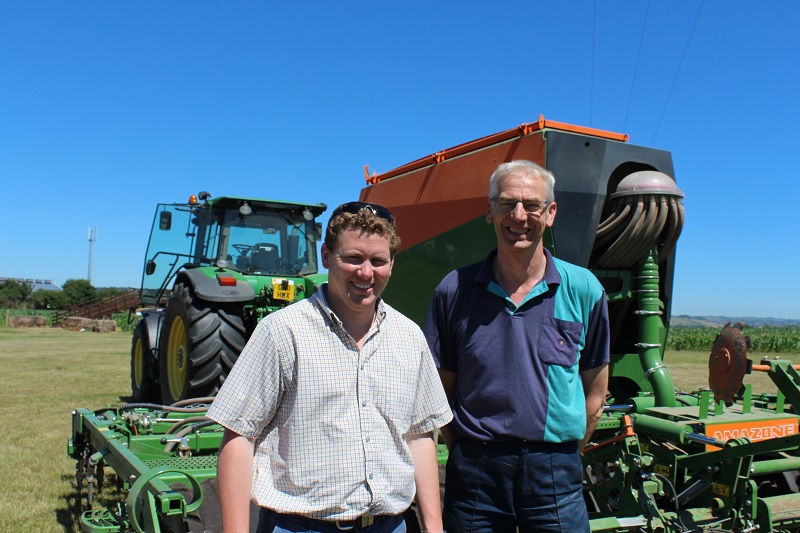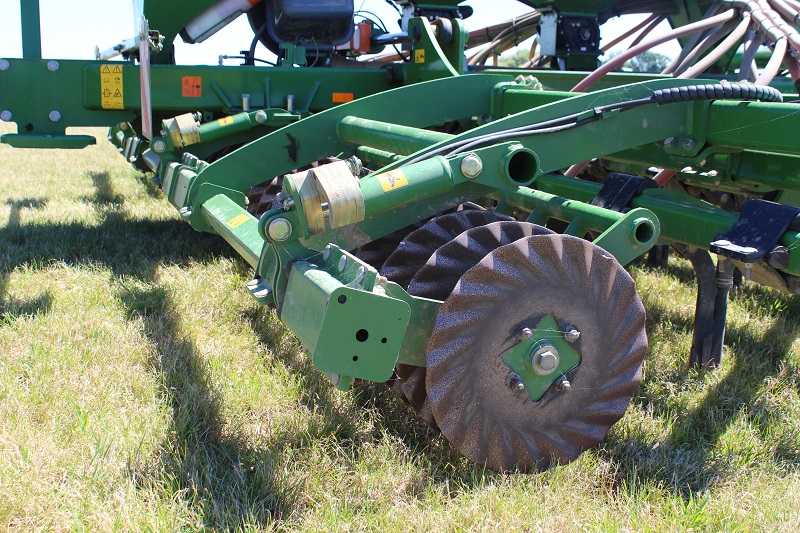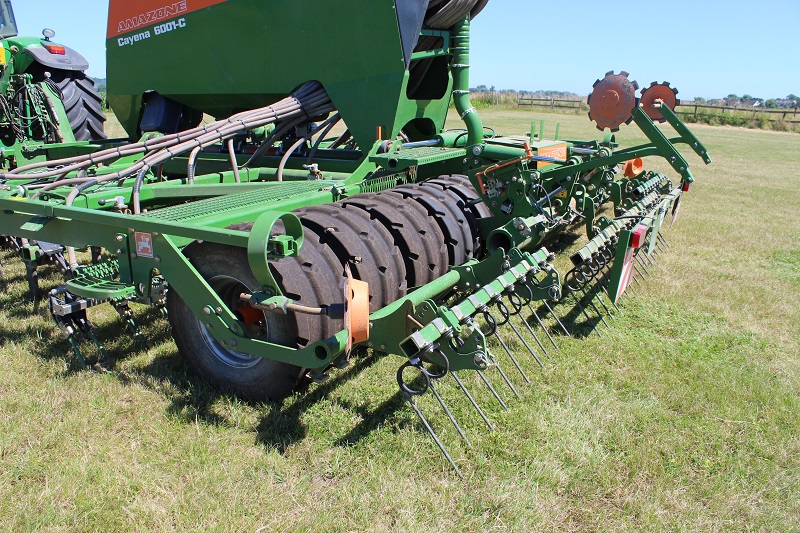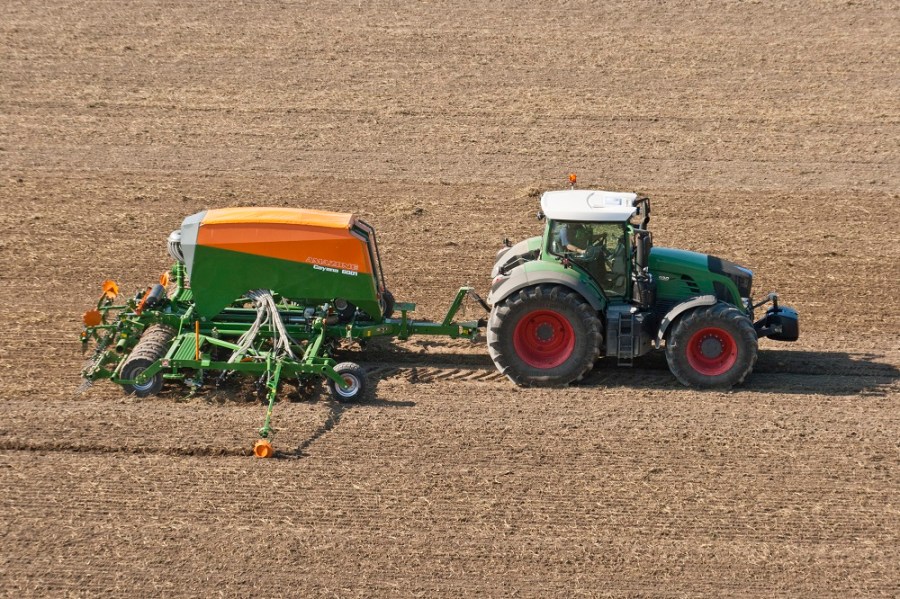Picking a new drill without trying it out on your farm first is always going to be a stab in the dark. CPM visits a Kent farm that trialled seven drills before settling on Amazone’s Cayena.
Right from the off, the crops planted with the Cayena had the most even establishment.
By James Andrews
Farming almost 10ft below sea level, where soils range from sand to clay and water levels keep rising is enough to challenge the versatility of any drill.
So when it came to make a change to the crop establishment regime at their 1200ha farm in Burmarsh, Romney Marsh, Rob and Alan Clifton-Holt opted to test out as many drills as they could before making any big investments.
The pair’s decision to switch things around came about in the autumn of 2013. Up until that point they’d almost exclusively been sowing winter crops, but the raising of water levels in the area and the onslaught of blackgrass

Alan Clifton-Holt (left), with farm foreman Jonathan Locke, put seven drills through their paces to determine which was best.
meant this was becoming increasingly unviable.
“The fact that we farm on a marsh means we’ve always got a pretty tight autumn window for establishing winter crops, but this got even tighter when the water levels started rising,” says Alan Clifton-Holt.
Now the farm’s drilling cut off is around 10 Oct, but in some years they’ll get a week in Nov when it dries up enough to get a bit done.
“Coupled to that, the blackgrass problem that we’d been battling for the past eight years was getting worse, as it just loved the wetter conditions and the fact that we were being forced to start drilling earlier,” he says.
Previously, the pair had tried to keep blackgrass levels under control using rotational grass leys, which were cut for silage. Over the years they had experimented with one, two, three and four-year leys, eventually finding that 18 months or two years was the most effective option.

A set of wavy front discs do the initial cultivation work.
This is because it gave just about enough time for all the surface blackgrass seeds to chit, grow and be removed without taking the ground out of more profitable cereal or oilseed production for too long.
But even though this prevented populations from ballooning, it wasn’t enough to start getting on top of the problem.
After weighing up all the options they decided that their next step would be to start increasing their spring cropping area.
Churning up a seedbed
Initially, they opted to get these spring crops in the ground using a similar approach to their autumn establishment. This involved churning up a seedbed using the farm’s Quivogne Tinemaster or Kuhn Roterra, rolling if needed and then going in with the 6m Väderstad Rapid.
Although this technique got the crops off to a decent enough start, the amount of damage and compaction caused in the still-wet soils meant they struggled later in the season.
“We knew we had to come up with a different approach, but we didn’t really know which way to turn,” says Alan

A sprung levelling harrow covers the seed before being pressed with a large-diameter rubber tyre packer.
Clifton-Holt. “That’s when we decided we’d better do some trials to find out, even though it would cost us quite a bit of money to do it.”
These would be far from scientific, but would give a good indicator of how each drill performed on their ground and with their farming approach, he adds.
So in the autumn of 2013, they set aside a 60ha block of land that had just come out of grass and been sprayed off to give a clean seedbed.
They then set about phoning round manufacturers and dealers to get hold of a series of demonstrator models.
Four drills – a mix of disc and tine direct drills – ended up arriving on the farm and each was given its own field to sow with winter wheat. They also set aside another field that would be planted using the current Väderstad system.
Bit of a disaster
Unfortunately, the trial turned out to be a bit of a disaster, but it wasn’t really the drills that were at fault. “On some, establishment was really patchy, partly because the drills struggled to close the slot in the springy turf,” says Alan Clifton-Holt.
“But the biggest problem was the massive flush of blackgrass that we had across the whole lot, including the ground that was ploughed and drilled by the Väderstad Rapid.”
In the end they decided to spray the whole lot off and redo the trial in the spring. This time around they got in three extra drills, taking the total up to seven.
These included a Simtech T-Sem, a John Deere 750A, a Sumo DTS and DD, a Weaving GD, a Väderstad Spirit, an Amazone Cayena and the farm’s Väderstad Rapid with the front row of discs removed.
All drills were put straight to work in the sprayed off stubbles from the winter crop planting spring wheat.
“The results were pretty variable, but right from the off, the crops planted with the Cayena had the most even establishment and looked the strongest going into the summer,” he recalls.
As well as its performance in the trial, the Clifton-Holts rated the Cayena for its versatility and the fact it would work well in a variety of conditions. “We wanted a drill that would be capable of direct drilling, but would also work well in cultivated ground when required,” he says.
“Some of the others seemed too focused on direct drilling alone and we just didn’t feel our ground was in a suitable condition for going down that route.
“At that stage we decided that the Amazone was the drill we wanted, even though we hadn’t had the trial harvest results.”
However, they would later find out that the Amazone-sown crop did actually return the highest yields.
With the decision made, the Clifton-Holts did a deal with local dealer RW Crawfords. This involved Crawfords buying a new Cayena, which would be used as a demonstrator throughout the 2014 autumn drilling season – including several demos on their farm – before they bought it for a slightly knocked-down price.
“It was a good deal for us as we paid a bit less, but it also gave the dealer a decent opportunity to show off what the drill could do without having to worry about selling it afterwards – they also sold a couple of drills off the back of it.”
So far the farm’s own Cayena has been used to drill the 2015/16 season’s cover crops, winter oilseed rape and spring cereals.
Cultivation work
For both the cover crops and the OSR, the Clifton-Holts decided to do some cultivation work before running in with the Cayena. This involved subsoiling any ground that needed it, before running through with a set of discs to loosen the soil and incorporate the previous crop’s residues.
Here the drill ran well and didn’t struggle to deal with the tilth or the relatively large amounts of crop residue on the surface.
Seed placement was also fairly consistent, but it did start to struggle where the ground was rougher than ideal. “Because it’s a fairly simple drill and all the coulters are mounted on a rigid frame, you don’t get the degree of contour-following that you would with independently mounted ones,” says Alan Clifton-Holt.
“However, it’s a good incentive for you to make sure your fields are nice and level, which they should be anyway.”
For spring cereal planting, they decided to direct drill into the desiccated cover crop, which is where the Cayena came into its own, notes Rob Clifton-Holt.
“One of the main reasons we bought the Cayena was its ability to direct drill in the spring without having to do any other damaging cultivation work,” he says.
“We made sure we did all the work we needed in the autumn before the cover crop went in and left just enough crumb in the soil for the spring crops to go into – it worked perfectly and you could barely see where we’d been.”
But despite the Cayena’s success, the trusty 6m Väderstad Rapid has been kept for autumn cereal drilling.
This is partly because it does some additional cultivation work and partly because seed placement is a little more accurate, says Alan Clifton-Holt.
Thankfully the Cayena threw up few teething problems, but they did find it was a little too easy to block spouts when drilling in stickier conditions. However, dropping the drill into work when they were moving at a decent speed solved this.
Other grumbles included the fact that when the drill lifts out of work it only runs on the transport wheels, rather than the entire width of the tyre packer.
In slightly wetter conditions this causes excess compaction and has caused them to go back in and rework the headlands after drilling the body of the field. “It’s not a massive deal and we do it with the Väderstad, too, as it’s such a heavy drill,” he says.
“However, if Amazone could tweak the design so that it turns on the whole packer, we’d probably be able to save the time and effort of going back through it.”
Tech Specs: AA Clifton’s Amazone Cayena
- Width: 6m
- Coulters: 36 TineTec coulters staggered over three rows and spaced at 16cm
- Hopper: 3600-litre spilt seed and fertiliser hopper with twin metering systems
- Pulled by: John Deere 7930
How it works
The Cayena is a fairly straightforward 6m tine drill that has 36 coulters staggered across three rows to improve trash flow.
These slender tines hang off the main frame on rubber mounts, which as well as allowing them to flex when they come into contact with large stones, causes them to vibrate and generate a bit more tilth. These work a little deeper than the wavy front discs that do the primary cultivation work.
The drill places both seed and fertiliser down the same tube, which runs down the back of the tine. This keeps things simple, but means there’s little room for experimenting with different placement options.
Once seed and fertiliser has been put in the ground, a sprung following harrow covers the opening with soil, before a set of rubber press wheels consolidates the seedbed. Finally, a tined following harrow textures the surface.
Rotational change
With the new drill settled, the Clifton-Holts were able to start implementing their new rotation. This would aim to split drilling equally between winter and spring as well as giving an opportunity for planting cover crops to increase soil organic matter.
They settled for the following six-year regime: winter OSR – winter wheat – cover crop – spring wheat – cover crop – spring peas – winter wheat – cover crop – spring barley – OSR.
For each cover crop they would aim to have a different seed mix that would avoid disease carryover into the following crop.
It’s still early to see if the rotation will have the desired effect as it only kicked off in the autumn of 2013. However, they’ve already started to see improvements in the workability of the soil.
That’s partly due to the cover crops and straw that has been incorporated for the past few years, but they’ve also been bringing in additional organic matter.
This has included bought-in FYM, FYM from muck-for-straw deals, compost and – for the first time this year – sewage sludge.
“It’s not a cheap hobby, but getting organic matter content higher and looking after the soil’s health is crucial if our family is still going to be farming here in generations to come,” says Alan Clifton-Holt.
Farm facts
AA Clifton, Burmarsh, Romney Marsh, Kent
- Farmed area: 1200 ha split across three holdings
- Staff: Three full-time, one semi-retired, one apprentice and one casual worker at busy times
- Soil types: Grade 1 silty sand and silty clay loam to Grade 2 silty clay




